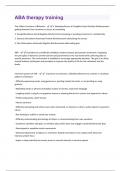Exam (elaborations)
ABA therapy training Updated 2025 with complete solution
- Course
- Institution
The 4 Main Functions of Behavior - 1. Attention/Access to Tangibles-Social Positive Reinforcementgetting attention from someone or access to something 2. Escape/Avoidance-Social Negative Reinforcement-escaping or avoiding someone or a task/activity 3. Sensory Stimulation-Automatic Positive Reinfo...
[Show more]



